Unlock the secrets of the blue birds in Michigan with this comprehensive and beautifully illustrated guide. Michigan, with its vast natural landscapes, plays host to a wide array of wildlife, including a stunning variety of blue birds.
This guide not only introduces you to 11 of these magnificent blue birds in Michigan, but also provides you with a FREE photo guide to help you identify and admire them in their natural habitat. Whether you are a birdwatching enthusiast or just starting your avian adventure, this guide is your key to the world of blue birds in Michigan.
Blue Birds Found In Michigan
This diverse geography of Michigan, combined with its location in the migratory path of many bird species, makes it a haven for birdwatchers. The vast expanses of forests provide a natural habitat for a variety of birds, while the numerous lakes, rivers, and wetlands attract waterfowl and shorebirds.
The state’s varying elevations and temperatures across different regions also contribute to a diverse range of habitats, which host a wide array of bird species, including an impressive variety of blue birds.
Eastern Bluebird
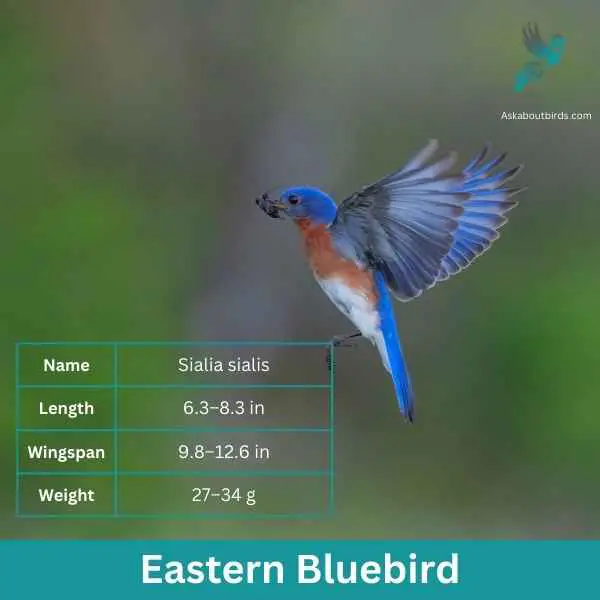
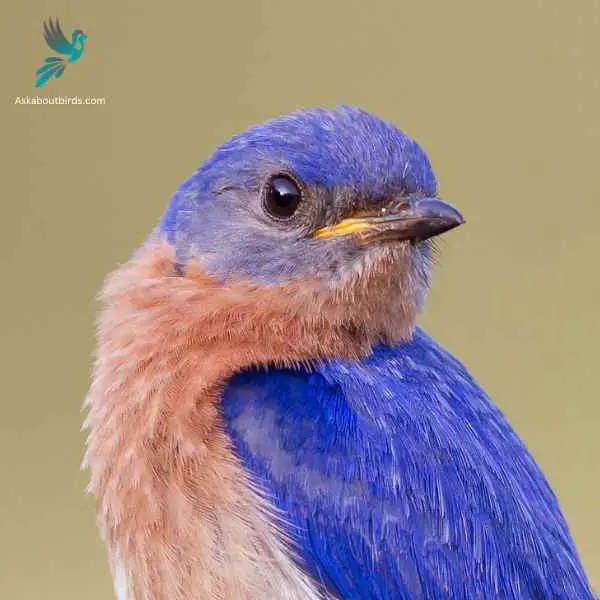
| Feature | Measurement |
|---|---|
| Scientific Name | Sialia sialis |
| Length | 6.3–8.3 in |
| Wingspan | 9.8–12.6 in |
| Weight | 27–34 g |
The Eastern Bluebird (Sialia sialis) is a small thrush found in open woodlands, farmlands, and orchards, and is recognized for its vibrant blue and red coloration. Male Eastern Bluebirds are dazzling with bright blue upperparts and a rusty or brick-red throat and breast, while females, though less colorful, still offer a similar pattern. The bird is native to North America and is commonly seen east of the Rockies, from Canada to the Gulf States and southeastern Arizona to Nicaragua.
Eastern Bluebirds feed on insects, wild fruit and berries. They have a gentle nature and are often seen perched alone or in small groups in the open, scanning the ground for prey. They are cavity nesters and will use old woodpecker holes or birdhouses if they are the right size.
Indigo Bunting


| Feature | Measurement |
|---|---|
| Scientific Name | Passerina cyanea |
| Length | 4.5–5.1 in |
| Wingspan | 7.1–9.1 in |
| Weight | 11.2–21.4 g |
The Indigo Bunting is a strikingly vibrant songbird, often hailed for its brilliant blue plumage and melodic song that graces woodlands and meadows during the warmer months.
Appearance: Males are renowned for their bright indigo blue feathers, which can appear darker in certain lights. Females and juveniles, on the other hand, are brown with subtle hints of blue on their wings and tail. The species lacks the vibrant streaking or spotting commonly found in many other songbirds.
Diet: Indigo Buntings primarily subsist on seeds, especially during non-breeding seasons. During the breeding season, they also consume a variety of insects such as beetles, caterpillars, and spiders, providing essential protein for their growing chicks.
Reproduction: Indigo Buntings build their nests close to the ground in shrubs or low tree branches. These nests, crafted meticulously with grasses and other plant materials, cradle clutches of typically 3 to 4 eggs. After hatching, the young are fed by both parents until they’re ready to fledge.
Blue Jay
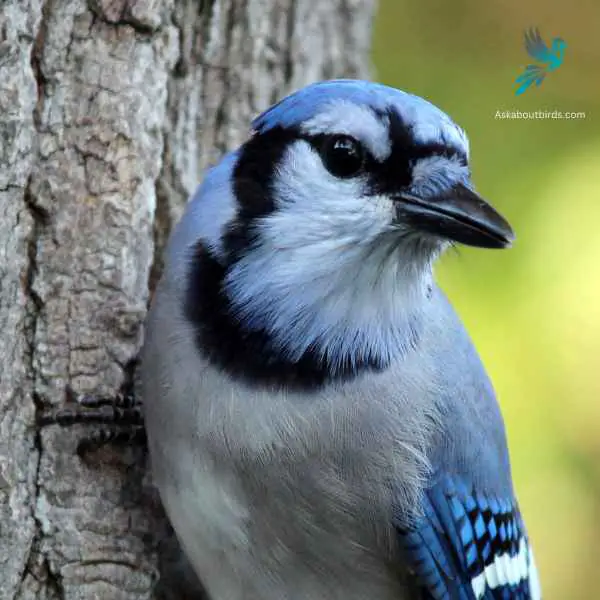
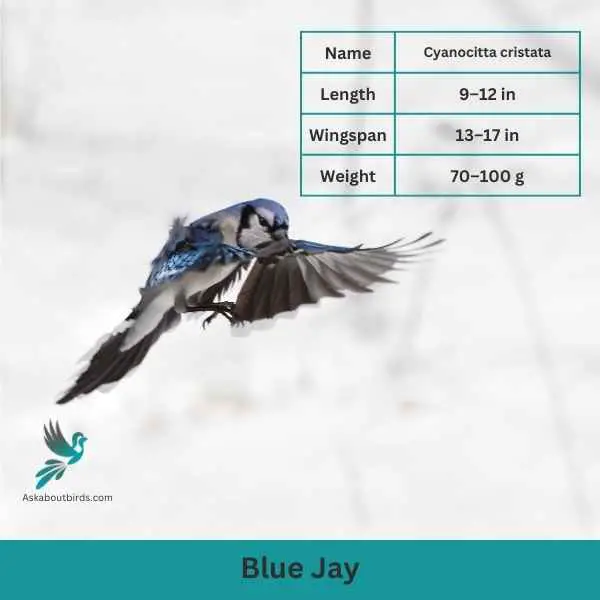
| Feature | Measurement |
|---|---|
| Scientific Name | Cyanocitta cristata |
| Length | 9–12 in |
| Wingspan | 13–17 in |
| Weight | 70–100 g |
The Blue Jay is a vibrant and easily recognized bird, known for its intelligence, distinctive calls, and bold behavior, commonly found throughout the eastern and central United States.
Appearance: The Blue Jay sports a striking blue upper body with white and black markings. Its face has a pronounced white patch with a black necklace that runs across the throat and around the head. The bird also features a pronounced blue crest, which can be raised or lowered, and its wings and tail are brightly colored with black bars and white tips.
Diet: Blue Jays are omnivores. Their diet consists primarily of seeds, nuts, especially acorns, fruits, and small insects. They’ve also been known to eat eggs or nestlings of other birds occasionally. Blue Jays often store food items in caches to eat later.
Reproduction: Blue Jays are monogamous birds that form long-lasting pair bonds. They typically build their nests in trees or large shrubs, constructing them from twigs, grass, and sometimes using mud as a binder. The female lays a clutch of 3 to 6 eggs, which are pale blue or sometimes white with brown speckles.
Cerulean Warbler
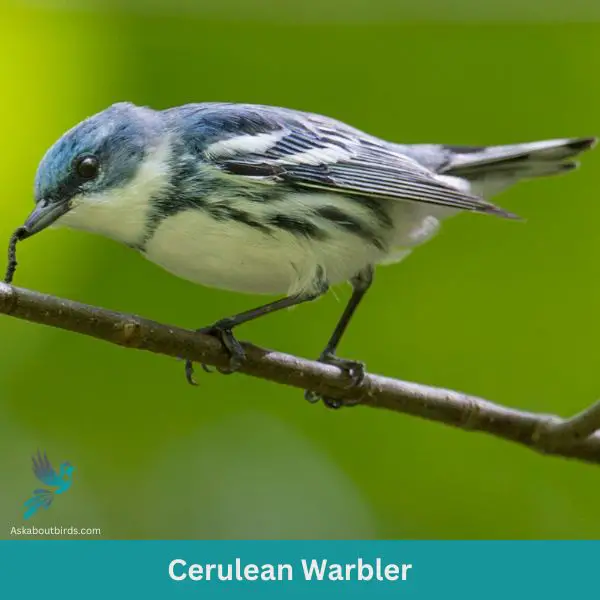
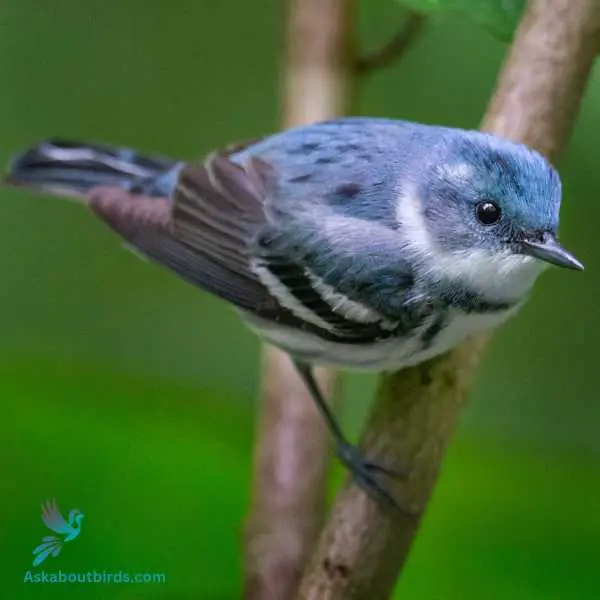
| Trait | Cerulean Warbler |
|---|---|
| Scientific Name | Setophaga cerulea |
| Length | 4.5 inches |
| Wingspan | 7.9-8.7 inches |
| Weight | 0.3-0.4 ounces |
The Cerulean Warbler is a striking songbird known for its sky-blue plumage and flitting movements in the forest canopy.
Appearance: Males boast a vibrant cerulean blue color on their upperparts, with streaked underparts, and a black necklace. Females have a more subdued bluish-green hue and lack the prominent black markings seen in males.
Diet: The diet of the Cerulean Warbler is predominantly made up of insects and spiders. They actively forage high in the treetops, gracefully maneuvering through leaves and branches.
Reproduction: Cerulean Warblers nest in the upper branches of tall deciduous trees. The female weaves a shallow cup-shaped nest and lays a clutch of 3-5 eggs.
Black-throated Blue Warbler
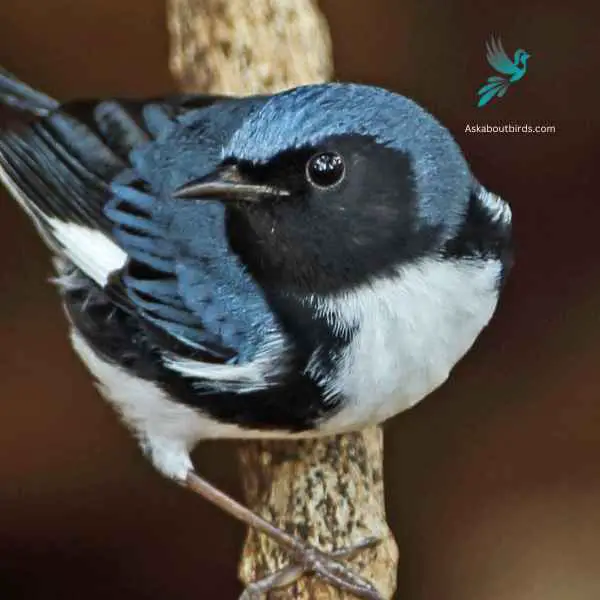
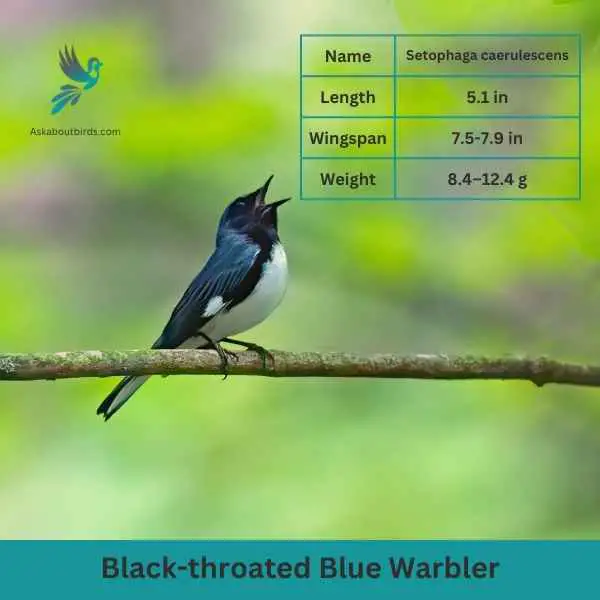
| Feature | Measurement |
|---|---|
| Scientific Name | Setophaga caerulescens |
| Length | 5.1 in |
| Wingspan | 7.5-7.9 in |
| Weight | 8.4–12.4 g |
The Black-throated Blue Warbler is a small migratory bird that breeds in the eastern United States and parts of Canada. The male Black-throated Blue Warbler displays a striking appearance with deep blue plumage on its upperparts, contrasting sharply with a black throat and a white belly. Females, on the other hand, have more muted colors, featuring grayish-olive plumage with a lighter throat.
These warblers prefer deciduous and mixed woodlands, where they forage actively for insects and spiders. They have a slender bill, which they use to extract prey from foliage and tree bark. During the breeding season, males perform courtship displays, showcasing their vibrant plumage and singing a high-pitched song to attract mates.
Black-throated Blue Warblers are known for their long-distance migration. They spend their winters in the Caribbean and Central America, where they inhabit various forested habitats. They construct cup-shaped nests in trees or shrubs, often placing them close to the ground.
Blue-headed Vireo
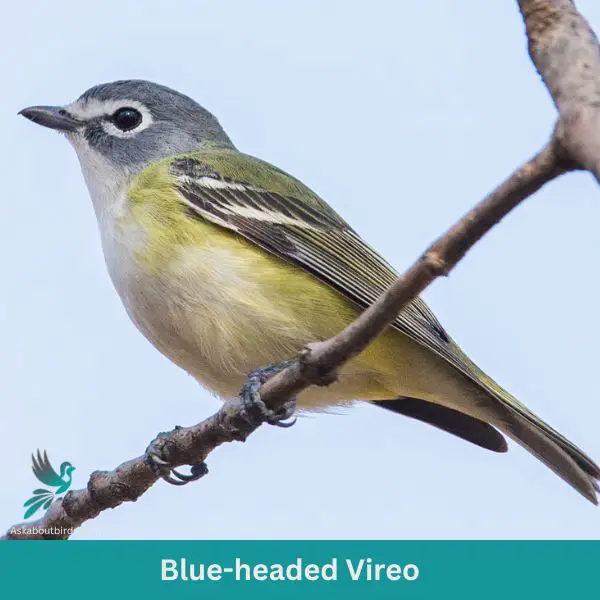
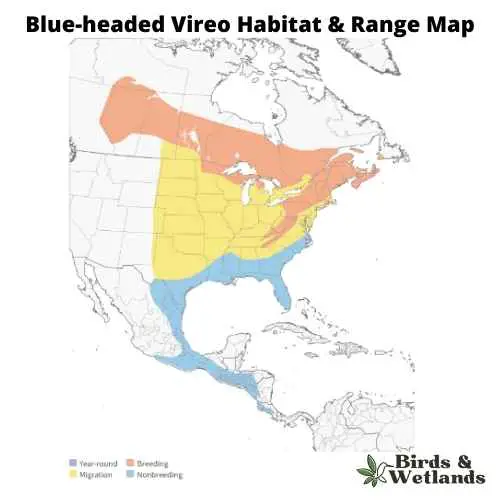
| Trait | Blue-headed Vireo |
|---|---|
| Scientific Name | Vireo solitarius |
| Length | 5-5.5 inches |
| Wingspan | 7.9-9.8 inches |
| Weight | 0.4-0.6 ounces |
The Blue-headed Vireo is a songbird recognized for its sharp and clear song as well as its distinct coloration.
Appearance: It has a blue-gray head and nape, contrasting sharply with its white throat and belly. A white eye ring combined with two white wing bars and yellowish flanks further accentuate its appearance.
Diet: The Blue-headed Vireo feeds mainly on insects and spiders. It often forages in the forest canopy, picking prey off leaves and twigs.
Reproduction: The female constructs a cup-shaped nest made of twigs, bark, and spiderwebs, often placed in the fork of a tree branch. Typically, she lays a clutch of 3-5 eggs. Both parents share the responsibility of incubating the eggs and feeding the chicks.
Tree Swallow
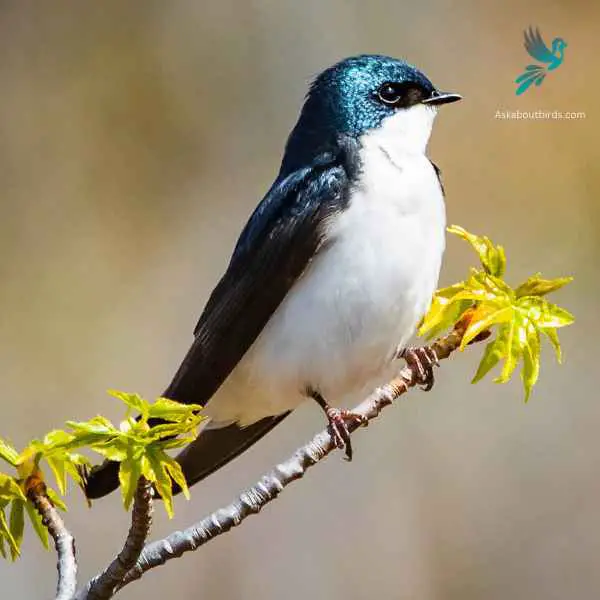
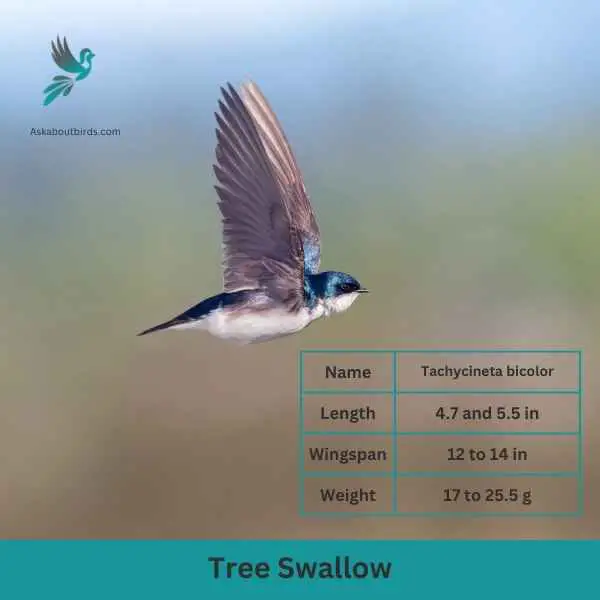
| Feature | Measurement |
|---|---|
| Scientific Name | Tachycineta bicolor |
| Length | 4.7 and 5.5 in |
| Wingspan | 12 to 14 in |
| Weight | 17 to 25.5 g |
The Tree Swallow is a graceful and agile bird, best recognized for its iridescent blue-green upperparts and sweeping flight patterns over open fields and water.
Appearance: The Tree Swallow is sleek with a streamlined body. The upperparts shine with a blue-green iridescence while the underparts are white. They possess long, pointed wings and a slightly forked tail, aiding in their agile flight.
Diet: Tree Swallows primarily feed on flying insects, skillfully catching them mid-air. During colder months when insects are scarce, they can switch to a diet of berries, particularly those of the bayberry, which other birds might find hard to digest.
Reproduction: Tree Swallows are cavity-nesters, typically choosing natural holes in trees or using bird boxes. They line their nests with feathers, creating a soft environment for the eggs. The female will lay a clutch of 4 to 7 white eggs.
Belted Kingfisher

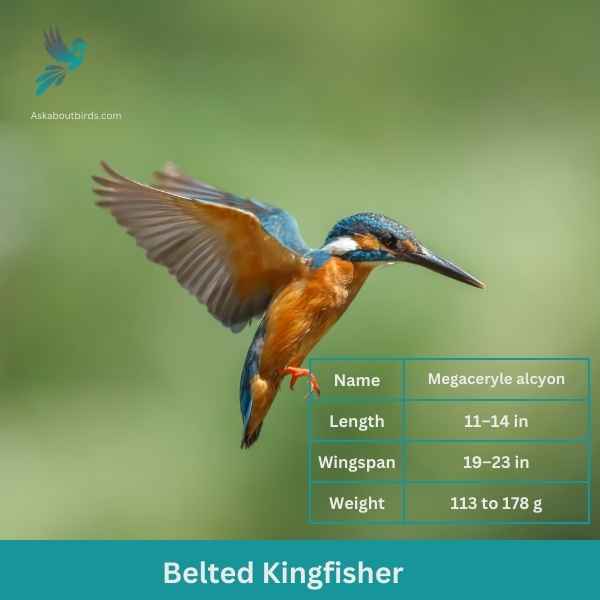
| Feature | Measurement |
|---|---|
| Scientific Name | Megaceryle alcyon |
| Length | 11–14 in |
| Wingspan | 19–23 in |
| Weight | 113 to 178 g |
The Belted Kingfisher is a distinctive and easily recognizable bird, frequently observed near water bodies, where it can be seen diving headfirst to catch prey.
Appearance: Sporting a prominent crest, the Belted Kingfisher has a slate blue-gray upper body and white underparts. Males possess a single blue band across their white chests, while females have an additional rufous band, making them one of the few bird species where females are more brightly colored than males. Their bill is long, sharp, and dagger-like.
Diet: As expert fishers, Belted Kingfishers mainly prey on small fish, but they’ll also consume crustaceans, insects, and amphibians. They’re known for their hunting tactic of hovering over water, spotting their prey, and then diving swiftly to snatch it.
Reproduction: Belted Kingfishers nest in burrows which they excavate in sandy or earthen banks, usually adjacent to water. The tunnel can be anywhere from 3 to 6 feet long, ending in a chamber. Within this chamber, the female lays a clutch of 5 to 8 white eggs.
Blue-gray Gnatcatcher
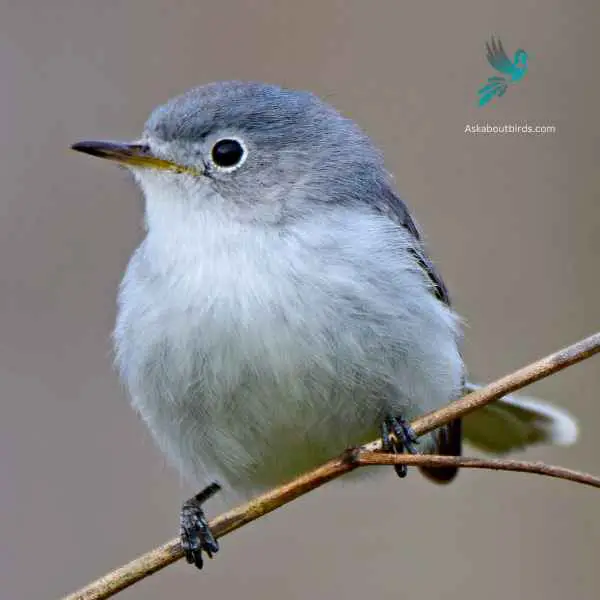
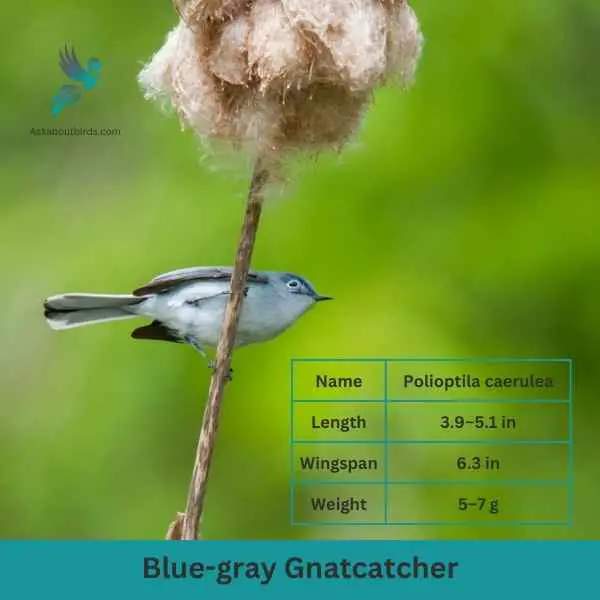
| Feature | Measurement |
|---|---|
| Scientific Name | Polioptila caerulea |
| Length | 3.9–5.1 in |
| Wingspan | 6.3 in |
| Weight | 5–7 g |
The Blue-gray Gnatcatcher is a petite, active bird, frequently observed flitting about treetops, emitting its distinctive high-pitched calls as it moves agilely through the branches.
Appearance: This bird exhibits a predominantly blue-gray plumage with a subtle white eye ring and long, slender tail feathers. The tail has distinctive black and white edging, with the males sometimes showing a faint black line on their forehead during the breeding season.
Diet: Blue-gray Gnatcatchers primarily feed on small insects and spiders. They’re adept hunters, foraging actively among foliage and even catching insects in mid-air.
Reproduction: These birds weave compact, cup-shaped nests on tree branches using plant materials, spider webs, and lichen. The exterior of the nest often matches the tree bark, making it well camouflaged. Inside, the female lays a clutch of 3 to 5 blue or greenish eggs, which she incubates.
Northern Parula
Scientific Name: Setophaga americana
Length: 4.3-4.7 in (11-12 cm)
Wingspan: 6.3-7.1 in (16-18 cm)
Weight: 0.2-0.4 oz (5-11 g)
The Northern Parula is a small, colorful warbler with a distinctive yellow throat and chestnut patch on its back.
Appearance: Both male and female Northern Parulas are similar in appearance, featuring a blue-gray upperpart, a yellowish throat and chest, a white belly, and a distinctive chestnut patch on the back. Males are generally brighter in color than females.
Diet: The diet of the Northern Parula primarily consists of insects and spiders, although they will also consume berries and nectar during certain seasons.
Reproduction: Northern Parulas nest in hanging vegetation, often using Spanish moss or usnea lichen. The female builds the nest and lays a clutch of 4 to 5 white eggs, speckled with brown. The female incubates the eggs and takes the lead in feeding the chicks, although the male may assist in feeding as well.
Blue-winged Warbler
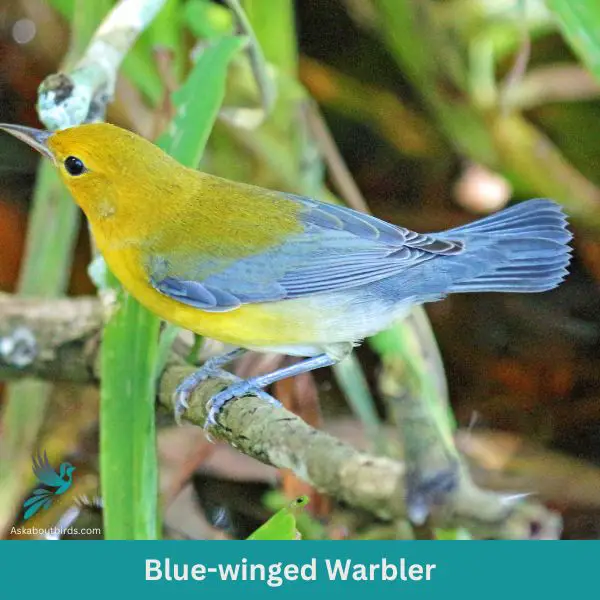
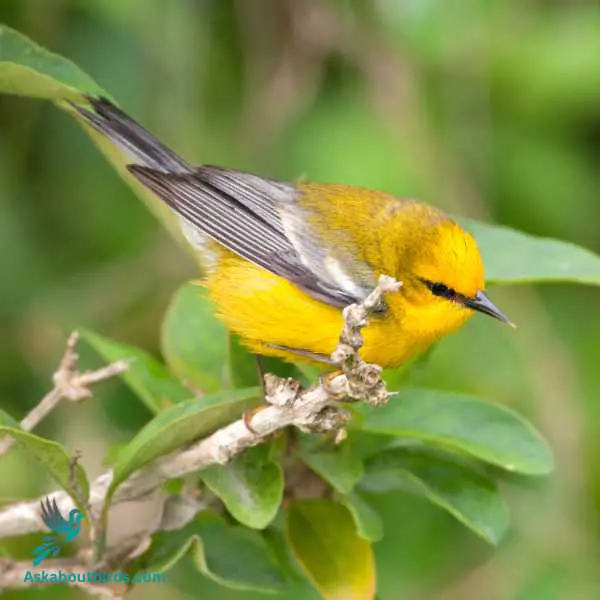
| Trait | Blue-winged Warbler |
|---|---|
| Scientific Name | Vermivora cyanoptera |
| Length | 4.3-4.7 inches |
| Wingspan | 6.7-7.5 inches |
| Weight | 0.3-0.4 ounces |
The Blue-winged Warbler is a vibrant songbird that stands out with its lemon-yellow coloring and buzzing song.
Appearance: This warbler displays a brilliant yellow body contrasted by blue-gray wings and a slim, black line through the eyes. The wings also feature two white wing bars.
Diet: The diet of the Blue-winged Warbler primarily consists of insects and spiders. They actively forage in shrubs and low trees, picking off their prey from the foliage.
Reproduction: Blue-winged Warblers build their nests on or near the ground, using grasses and other fine materials. The female lays a clutch of 4-6 eggs, which she incubates.
Where to Spot Michigan’s Blue Birds
Michigan, with its vast forests, numerous lakes, and varied topography, is a paradise for bird watchers, particularly those in search of the elusive blue birds. Here are some top locations in Michigan known for their bird diversity:
- Tawas Point State Park: Often referred to as the “Cape May of the Midwest,” this park is a hotspot for migratory birds, especially in the spring and fall. Its unique location on Lake Huron attracts a variety of bird species, including the Eastern Bluebird.
- Magee Marsh Wildlife Area: Located on the southern shore of Lake Erie, this marsh is one of the best birdwatching spots in the Midwest. It is particularly famous during the spring migration, attracting a variety of warblers and the vibrant Indigo Bunting.
- Sleeping Bear Dunes National Lakeshore: A diverse habitat of dunes, forests, and wetlands, this area is home to many bird species, including the Blue Jay and the Tree Swallow. The varied terrain makes it a great spot for bird watching throughout the year.
- Seney National Wildlife Refuge: This refuge in the Upper Peninsula provides a habitat for over 200 bird species, including the Belted Kingfisher and the Common Nighthawk. Its extensive wetlands and forests attract a wide variety of waterfowl and songbirds.
- Pointe Mouillee State Game Area: Located on the western shore of Lake Erie, this area is a crucial stopover for migratory birds. It is one of the best places in Michigan to see shorebirds, including the Sandhill Crane and the Black-crowned Night Heron.
| Neighboring States | Top Spots for Blue Birds |
|---|---|
| Ohio’s Blue Birds | 1. Magee Marsh Wildlife Area 2. Ottawa National Wildlife Refuge 3. Cuyahoga Valley National Park |
| Indiana’s Blue Birds | 1. Indiana Dunes National Park 2. Eagle Creek Park 3. Goose Pond Fish and Wildlife Area |
| Wisconsin’s Blue Birds | 1. Horicon Marsh 2. Crex Meadows Wildlife Area 3. Chequamegon-Nicolet National Forest |
FAQs on Blue Bird Species Found in Michigan
How to Attract Eastern Bluebirds to Your Yard?
To attract Eastern Bluebirds, consider setting up nest boxes and bird feeders filled with their preferred food like sunflower seeds. These small blue birds are particularly fond of open spaces dotted with scattered trees. They are generally found in deciduous and mixed forests but are increasingly making their way into urban and suburban areas. A male Eastern Bluebird is easily recognizable by its bright blue plumage and reddish-brown breast. Creating the right habitat, with tall trees for nesting and plenty of open ground for foraging, is essential. Also, avoid using pesticides in your garden; these birds eat insects and can help with natural pest control.
What are the Nesting Habits of Purple Martins?
Purple Martins are fascinating wild birds that are native to Central and South America but migrate north for breeding. Unlike many small birds, Purple Martins often prefer man-made nesting sites, particularly nest boxes and even complex “martin houses” if available. These birds are highly social and usually nest in colonies, sometimes sharing space with other species. They prefer tall trees and other high structures for their nesting sites. The presence of water is often a crucial factor in their choice of location, as they frequently feed on flying insects that congregate around water bodies.
What’s the Difference Between Mountain Bluebirds and Eastern Bluebirds?
Mountain Bluebirds and Eastern Bluebirds are both beautiful, blue-colored birds but have different ranges and habitats. The Mountain Bluebird is typically found in the western United States and is identifiable by its light gray belly and brighter blue wings. In contrast, the Eastern Bluebird is primarily found in the eastern half of the United States and features a rusty red breast. While Mountain Bluebirds are more likely to be found in open, mountainous areas, Eastern Bluebirds prefer deciduous forests and mixed forests, often near open areas for foraging.
What Foods Do Great Blue Herons Prefer?
Great Blue Herons are versatile predators that catch fish as their primary food source but are also known to eat small mammals, insects, and even other birds. Found commonly in both Northern and Southern Michigan, these large, grayish-blue birds often inhabit areas close to water bodies. Their long, pointed bills are perfectly adapted for spearing fish. Unlike many smaller, seed-eating birds, Great Blue Herons do not visit bird feeders but are an awe-inspiring sight near rivers, lakes, and marshes.
